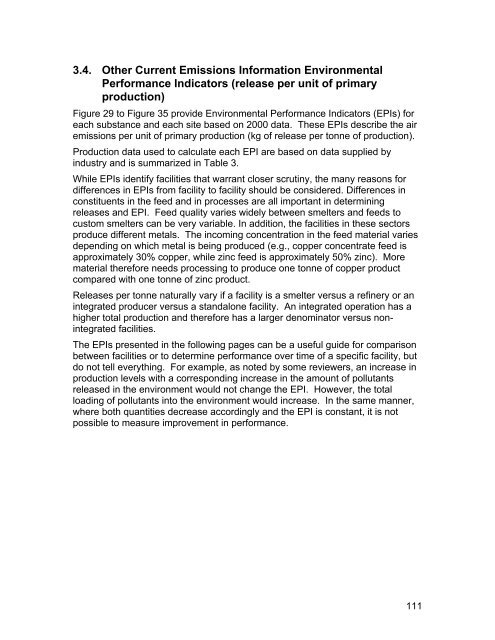(MERAF) for the Base Metals Smelting Sector - CCME
(MERAF) for the Base Metals Smelting Sector - CCME
(MERAF) for the Base Metals Smelting Sector - CCME
Create successful ePaper yourself
Turn your PDF publications into a flip-book with our unique Google optimized e-Paper software.
3.4. O<strong>the</strong>r Current Emissions In<strong>for</strong>mation Environmental<br />
Per<strong>for</strong>mance Indicators (release per unit of primary<br />
production)<br />
Figure 29 to Figure 35 provide Environmental Per<strong>for</strong>mance Indicators (EPIs) <strong>for</strong><br />
each substance and each site based on 2000 data. These EPIs describe <strong>the</strong> air<br />
emissions per unit of primary production (kg of release per tonne of production).<br />
Production data used to calculate each EPI are based on data supplied by<br />
industry and is summarized in Table 3.<br />
While EPIs identify facilities that warrant closer scrutiny, <strong>the</strong> many reasons <strong>for</strong><br />
differences in EPIs from facility to facility should be considered. Differences in<br />
constituents in <strong>the</strong> feed and in processes are all important in determining<br />
releases and EPI. Feed quality varies widely between smelters and feeds to<br />
custom smelters can be very variable. In addition, <strong>the</strong> facilities in <strong>the</strong>se sectors<br />
produce different metals. The incoming concentration in <strong>the</strong> feed material varies<br />
depending on which metal is being produced (e.g., copper concentrate feed is<br />
approximately 30% copper, while zinc feed is approximately 50% zinc). More<br />
material <strong>the</strong>re<strong>for</strong>e needs processing to produce one tonne of copper product<br />
compared with one tonne of zinc product.<br />
Releases per tonne naturally vary if a facility is a smelter versus a refinery or an<br />
integrated producer versus a standalone facility. An integrated operation has a<br />
higher total production and <strong>the</strong>re<strong>for</strong>e has a larger denominator versus nonintegrated<br />
facilities.<br />
The EPIs presented in <strong>the</strong> following pages can be a useful guide <strong>for</strong> comparison<br />
between facilities or to determine per<strong>for</strong>mance over time of a specific facility, but<br />
do not tell everything. For example, as noted by some reviewers, an increase in<br />
production levels with a corresponding increase in <strong>the</strong> amount of pollutants<br />
released in <strong>the</strong> environment would not change <strong>the</strong> EPI. However, <strong>the</strong> total<br />
loading of pollutants into <strong>the</strong> environment would increase. In <strong>the</strong> same manner,<br />
where both quantities decrease accordingly and <strong>the</strong> EPI is constant, it is not<br />
possible to measure improvement in per<strong>for</strong>mance.<br />
111
















